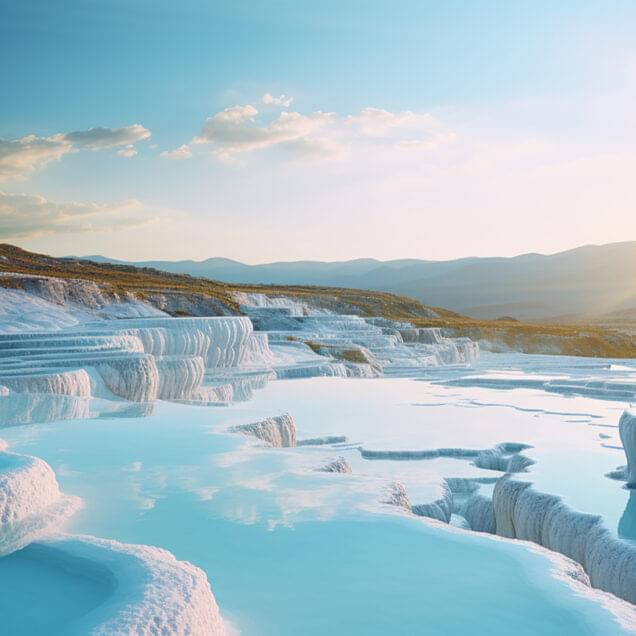

Overview
Pamukkale: A Natural Marvel and Ancient Oasis in Western Turkey
Pamukkale, situated in the western part of Turkey, is a mesmerizing destination renowned for its unique natural wonders and rich historical heritage. In this comprehensive exploration of Pamukkale, we will delve into the extraordinary terraces of white travertine, uncover the ancient city of Hierapolis, embrace the healing properties of thermal springs, and discover the timeless allure that makes Pamukkale a captivating gem in Turkey.
Map
Info
Travertine Terraces: Nature’s Artistry Unveiled
Pamukkale’s most iconic feature is the otherworldly travertine terraces, often referred to as “Cotton Castle.” These dazzling white terraces are formed by the mineral-rich thermal waters cascading down the hillsides, creating a series of pools and terraces that resemble a frozen, cascading waterfall. The calcium carbonate deposits give the landscape a surreal, ethereal appearance.
Visitors have the opportunity to walk barefoot on the terraces, experiencing the soothing sensation of the warm, mineral-rich water. The terraces are ever-changing, with the sunlight casting different hues on the white surface throughout the day, creating a magical and constantly evolving landscape.
Hierapolis: Ancient Ruins Amidst Natural Splendor
Perched above the travertine terraces lies the ancient city of Hierapolis, a UNESCO World Heritage Site. Founded in the 2nd century BCE, Hierapolis flourished as a Greco-Roman city, and its ruins provide a glimpse into the city’s historical and architectural significance. The well-preserved theater, necropolis, and ancient streets transport visitors back in time, offering a tangible connection to the city’s past.
The Hierapolis Archaeology Museum, located near the entrance, houses artifacts and sculptures unearthed from the site, providing further insights into the daily life and cultural achievements of this ancient city.
Healing Waters: Thermal Springs and Cleopatra’s Pool
Pamukkale’s thermal springs have been renowned for their healing properties for millennia. The warm, mineral-rich waters are believed to alleviate various ailments and promote well-being. Cleopatra’s Pool, also known as the Antique Pool, is a highlight within the archaeological site. The submerged ancient columns in the pool add a unique touch, inviting visitors to immerse themselves in the therapeutic waters.
The modern Pamukkale Thermal Pools, located adjacent to the travertine terraces, provide additional opportunities for relaxation and rejuvenation. Visitors can unwind in the naturally warm pools while taking in the panoramic views of the surrounding landscape.
Cultural Riches: Hierapolis Theater and Ancient Streets
The Hierapolis Theater, with its commanding position overlooking the valley, is a testament to the city’s cultural vibrancy. Built during the Roman period, the theater could accommodate thousands of spectators and hosted various performances and events. Today, it stands as an impressive architectural marvel, offering visitors a chance to witness the grandeur of ancient entertainment venues.
Wandering through the ancient streets of Hierapolis, visitors can explore the remnants of ancient shops, agora, and monumental gates. The city’s well-planned urban layout showcases the ingenuity of its ancient architects and provides a glimpse into daily life in a thriving Greco-Roman metropolis.
Modern Pamukkale: A Harmonious Blend of Nature and Tourism
While Pamukkale is deeply rooted in history, the modern town that has developed around the natural wonder offers amenities and services for today’s travelers. The town features a range of accommodations, restaurants, and shops, creating a comfortable base for those exploring the region.
The town’s proximity to other attractions, such as the ancient city of Aphrodisias and the Laodikeia archaeological site, adds to the appeal of Pamukkale as a hub for cultural and historical exploration.
Practical Tips for Exploring Pamukkale
For those planning a visit to Pamukkale, it’s advisable to wear suitable footwear for walking on the travertine terraces, as well as bringing swimwear if intending to enjoy the thermal pools. Sunscreen and hats are essential, given the region’s sunny climate, particularly during the summer months.
Pamukkale’s peak visitor times are during the spring and autumn when the weather is mild. Early morning or late afternoon visits provide the best lighting for capturing the terraces’ beauty and avoiding the heat of the midday sun.
In Conclusion: Nature’s Masterpiece and Ancient Marvels
Pamukkale, with its ethereal travertine terraces, ancient city ruins, and healing thermal waters, offers a harmonious blend of nature and history. Whether immersing oneself in the warm pools, exploring the ancient streets of Hierapolis, or marveling at the natural beauty of the travertine terraces, Pamukkale promises a multifaceted experience that captivates the senses. As visitors traverse the landscape, they become part of a timeless narrative, connecting with both the ancient past and the awe-inspiring forces of nature that continue to shape this extraordinary






